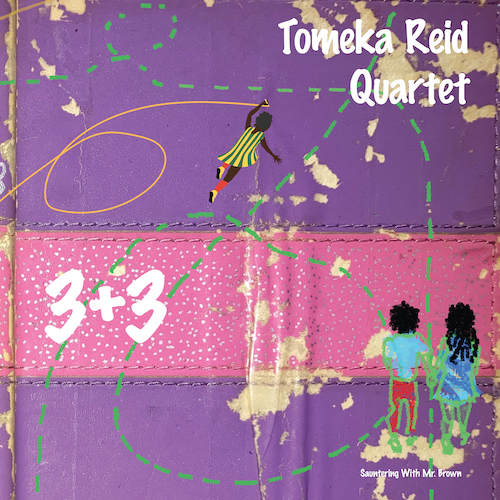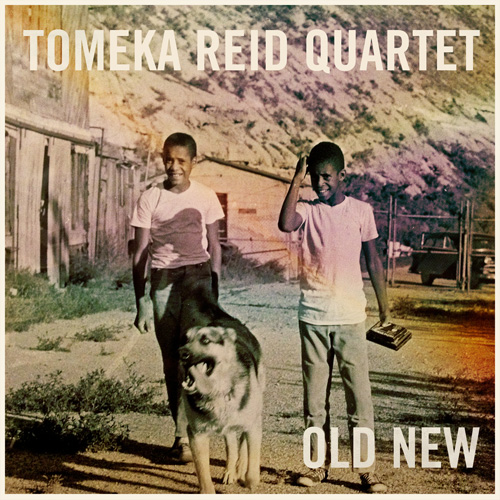Moving to Chicago in 2000 to attend a graduate music program at DePaul University she connected with flutist/composer Nicole Mitchell, a relationship that recalibrated her entire aesthetic orientation. While she was embraced by the improvisational music scene, Reid learned to make her own way, which was both liberating and extremely challenging. She found the ideal outfits for evolution as a member of several celebrated Chicago bands.
She co-leads the adventurous string trio Hear in Now with violinist Mazz Swift and bassist Silvia Bolognesi. When the time came to launch a band to play her original music, she sought out advice from Nicole Mitchell, who suggested Halvorson. Reid was already working with Fujiwara in Mike Reed’s fascinating Sun Ra-inspired ensemble Living By Lanterns (which released the acclaimed 2012 Cuneiform album Old Myth, New Science). Approaching both players made eminent sense. Halvorson and Fujiwara already played together in the collective trio Thumbscrew with bassist Michael Formanek, and power Formanek’s Ensemble Kolossus. The three of them are also the foundation of Halvorson’s quintet Code Girl, a project introduced on the acclaimed 2018 album of the same name. Halvorson and Fujiwara first started playing together in cornetist Taylor Ho Bynum’s Sextet (Reid joined an expanded version of the band on 2016’s Enter the PlusTet). Among other bands, they also work together in the collective quartets Reverse Blue (with Chris Speed and Eivind Opsvik) and The Thirteenth Assembly (with Bynum and violist Jessica Pavone), and the trio The Outlouds with clarinetist Ben Goldberg.
 3+3 RUNE 525 |
No artist over the past decade has done more to bring the cello from the margins to the center of the contemporary jazz scene than Tomeka Reid. Nurtured by the creative hothouse of Chicago’s AACM, she’s recorded prolifically since making her debut on flutist Nicole Mitchell’s 2002 Black Earth Ensemble album Afrika Rising. But with 3+3, Reid takes a major step as a composer with a bold and protean approach to designing settings for group improvisation. Set up by Halvorson and Tomas “Exploring Outward / Funambulist Fever” features some of Reid’s most exquisite playing. The quartet’s arresting use of space, with quiet, abstract passages bleeding into denser group improv and brisk call and response themes, maintain dramatic tension until the dramatically abrupt conclusion. It’s liberatory music that takes these well-traveled musicians into places and spaces where unheard facets of their sounds are revealed. |
 OLD NEW RUNE 465 |
"Old New is bubbling with ideas, as well as an energy that feels too surging to be over-composed but too exacting to be improvised. A great listen." – Music Tap The jazz polls might still list cello under the miscellaneous instrument category, but in the hands of Tomeka Reid it’s an essential vehicle for unfettered jazz exploration. Old New,
the second album by the Tomeka Reid Quartet, is a project that
exemplifies why she’s quickly become a definitive figure on the 21st
century jazz scene. As a composer, arranger, improviser, bandleader,
and impresario, she embodies jazz’s progressive ethos. Crafting
memorable tunes brimming with arresting textures and melodies, Reid
creates music palpably connected to the tradition while recasting those
sounds to meet her own expressive needs. Old new, indeed! While Reid has recorded prolifically since making her debut on flutist Nicole Mitchell’s 2002 Black Earth Ensemble album Afrika Rising (DreamTime Records), Old New is only her second album leading her own band, following up on the eponymous Tomeka Reid Quartet (Thirsty Ear). Like that 2015 release, the band’s second album features a brilliant cast with guitarist Mary Halvorson and drummer Tomas Fujiwara, who play together in at least half a dozen different ensembles, and Chicago bassist Jason Roebke. It’s essentially a string band, an electro-acoustic hybrid in which any player might take on bass, melodic or rhythmic responsibilities at any given time. “I wanted to have a string-centered group,” says Reid, who was recently voted Violinist/Violist/Cellist of the Year for the second consecutive time by the Jazz Journalists Association. “I wanted a harmonic instrument, but not piano and I wanted to go in a different direction. For this quartet I like Mary’s manner of using pedals in interesting and creative ways. You can hear right away that it’s her. I like that contrast with me being all acoustic in this ensemble.” Based in Queens since 2016, Reid wrote much of the Old New music with the support of a grant from Roulette Intermedium. The album opens with the title track, a slippery piece that almost serves as a manifesto for an artist consciously building on the work of her most adventurous string predecessors. It’s a Reid original “that’s an old form, a hymn,” she says. In much the same way, “Wabash Blues” opens with Fujiwara’s clattery trap work, a jittery introduction for an incident-filled soundscape inspired by the changeable energy of the Chicago block where she lived before moving to New York City. Reid is as effective evoking people as places. “Niki's Bop” is a tribute to her dear friend and mentor Nicole Mitchell, a joyous, terpsichorean line that practically shimmies. “I could imagine her playing that melody on flute,” Reid says. “She’s a huge inspiration in my life. There’s nothing better than writing a song for somebody.” Mary Halvorson was a source of inspiration for “Ballad” and the piece’s coiled energy, conversational flow and wry asides seem to reveal facets of the guitarist that aren’t necessarily apparent. “The melody reminded me of something about Mary’s personality, sweet, no nonsense, reserved, and yet funnier than most people might know,” Reid says. Written for her maternal grandmother, “Sadie” is a boppish line that’s as poised and elegant as the woman herself. Designed to feature Roebke, “Edelin” is a mysterious, slow-breath piece that takes on density as it goes. “Jason should be much better known,” Reid says. “He does great, interesting work, and being in Chicago you can get overlooked. There are so many people doing interesting things there.” Reid closes the album with “Peripatetic,” an Anthony Braxton-inspired tune that covers a lot of distance in a relatively short span, from the portentous opening statement to the skittery mid-section to the almost operatic conclusion. Speaking of gorgeous melodies, the pizzicato-powered “RN” offers a glimpse at Reid’s love of pop music, with its incantatory refrain and unabashed lyricism. It’s a sweet sign off, and an implicit promise that there are many more realms for this band to investigate. If Reid’s music seems to draw on a multiplicity of sources, that’s because she’s absorbed a mind-boggling array of influences in a relatively short period of time. Over the past decade she’s collaborated with veteran visionaries connected to Chicago’s Association for the Advancement of Creative Musicians (AACM), performing and recording with Anthony Braxton, Nicole Mitchell, Roscoe Mitchell (no relation) and the collective he co-founded, the Art Ensemble of Chicago. She’s also worked closely with contemporaries such as drummer Mike Reed, cornetist Taylor Ho Bynum, and veteran masters such as Nicole Mitchell and pianist Myra Melford, among many others. Reid has embraced her role as a champion of creative string players, on and off the bandstand. “I’m a big advocate for strings in improvised music, particularly violinists, violists and cellists who are their own leaders,” says Reid, who founded and runs the Chicago Jazz String Summit. “A lot of my projects are centered around string players.” “What’s awesome as a cellist
is that we can create a sound for ourselves,” said Reid, who was
recently awarded a prestigious grant from the Foundation for
Contemporary Arts. “We do have a history, but not the same kind as
trumpet, saxophone and pianists for example, with hundreds and hundreds
of predecessors. I’ve come to appreciate that a lot more.” With Old New, Tomeka Reid has staked another flag in the future. |
PRESS RELEASES
3+3 press release
Old New press release
